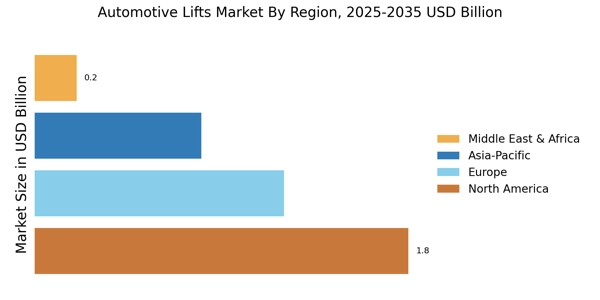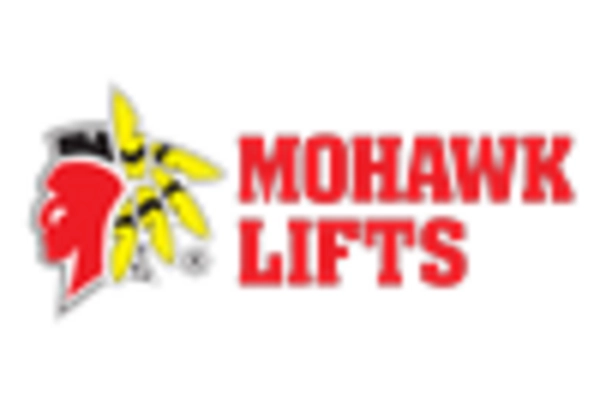Increasing Vehicle Production
The Automotive Lifts Market is experiencing growth due to the rising production of vehicles across various segments. As manufacturers ramp up production to meet consumer demand, the need for efficient lifting solutions becomes paramount. In 2025, the automotive sector is projected to produce over 90 million vehicles, necessitating advanced lifting equipment for assembly lines and maintenance facilities. This surge in vehicle production drives the demand for automotive lifts, as they facilitate the efficient handling of vehicles during manufacturing and servicing. Consequently, the Automotive Lifts Market is likely to witness a significant uptick in sales, as manufacturers seek to enhance operational efficiency and reduce downtime.
Growth in Electric Vehicle Adoption
The shift towards electric vehicles (EVs) is reshaping the Automotive Lifts Market. As more consumers opt for EVs, the automotive sector is adapting to accommodate this change. By 2025, it is anticipated that electric vehicles will constitute approximately 25% of new car sales. This transition necessitates specialized lifting solutions designed for the unique requirements of EVs, such as battery access and weight considerations. Consequently, the Automotive Lifts Market is likely to see an increase in demand for lifts that cater specifically to electric vehicles, driving innovation and diversification in product offerings.
Expansion of Automotive Service Centers
The proliferation of automotive service centers is a key driver for the Automotive Lifts Market. As vehicle ownership continues to rise, the demand for maintenance and repair services escalates. In 2025, the number of automotive service centers is expected to exceed 200,000, creating a substantial market for automotive lifts. These service centers require reliable lifting solutions to perform repairs and inspections efficiently. The Automotive Lifts Market stands to benefit from this trend, as service centers invest in modern lifting equipment to improve service quality and customer satisfaction. This expansion not only boosts sales but also encourages innovation in lift technology.
Regulatory Compliance and Safety Standards
The Automotive Lifts Market is influenced by stringent regulatory compliance and safety standards. Governments and industry bodies are implementing regulations to ensure the safety and reliability of automotive lifting equipment. By 2025, it is projected that compliance with these standards will be mandatory for all automotive lifts sold in various markets. This regulatory landscape compels manufacturers to invest in high-quality, compliant lifting solutions, thereby driving demand within the Automotive Lifts Market. As businesses prioritize safety and compliance, the market is likely to see an increase in the adoption of certified lifting equipment, further propelling industry growth.
Technological Integration in Lifting Solutions
The integration of advanced technologies into automotive lifts is a significant driver for the Automotive Lifts Market. Innovations such as IoT connectivity, automation, and enhanced safety features are becoming increasingly prevalent. In 2025, it is expected that over 30% of new automotive lifts will incorporate smart technology, allowing for real-time monitoring and diagnostics. This technological advancement not only improves operational efficiency but also enhances safety standards in automotive service environments. As a result, the Automotive Lifts Market is poised for growth, as businesses seek to adopt these cutting-edge solutions to remain competitive and meet regulatory requirements.


















Leave a Comment